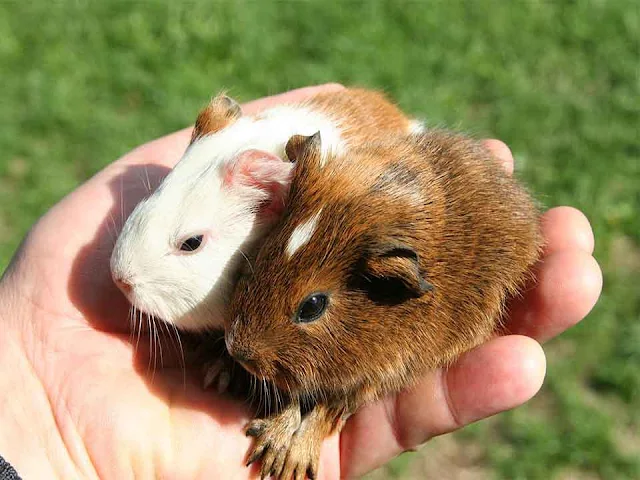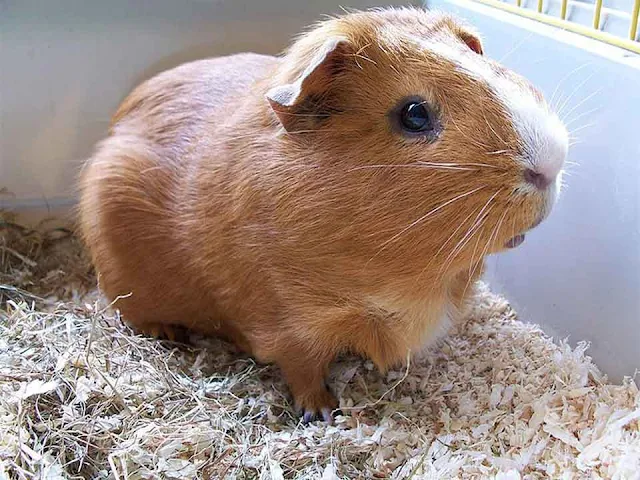Guinea Pig or often called “Domestic Guinea Pig” also famous
as “Cavy” or “Domestic Cavy”, is a breed of rodent belonging to the family “Caviidae”
and the genus “Cavia”. In spite of the common name, Guinea Pigs are not in the pig
family ‘Suidae’, nor come from ‘Guinea’ in Africa. Guinea Pigs are originated
in ‘Andes’ of South America.
Domestic Guinea Pig plays a vital role in common culture for various
native Andean groups, particularly as a food source, but also in traditional
medicine and in public spiritual ceremonies.
Weight and Length
Guinea Pigs are large for rodents, weighing between 700 and
1,200 g (1.5 and 2.6 lbs), and measuring between 20 and 25 cm (8 and 10 in) in
length. Modern breeding of cute Guinea Pigs has resulted in animals weighing
2,700 grams (6.0 lb).
Lifespan
The average lifespan of Guinea Pigs is four to five years but
they can live up to eight years. The recorded lifespan of Guinea Pigs as per ‘Guinness
World Records’ is 14 years and 10.5 months.
Popularity
In Western cultures, Domestic Guinea Pigs have gained extensive
popularity as a domestic pet which is a for ‘Pocket Pet’. Their passive nature;
welcoming, even loving reaction to hold and nourishing, and the comparative easiness
of caring for them continue to make Guinea Pigs a famous domestic pet. Some organizations
have been established worldwide to breed Guinea Pigs. Some particular breeds having
varied coat colors and textures as selected by the breeders.
Guinea Pigs are still used in the research, mostly as models
for human medical disorders including juvenile diabetes, tuberculosis, scurvy,
and pregnancy impediments.
Domestic Habitat
Domesticated Guinea Pigs flourish in clutches of two or more.
Guinea Pigs learn to identify and bond with other single pigs, and challenging in
pigs shows. The group of pigs can be side by side if their cage has sufficient
space.
Domestic Guinea Pigs have established a diverse biological
rhythm from their wild complements, and they have longer periods of movement
followed by a short-time asleep. Activity is distributed arbitrarily all over
the day. The Domestic Guinea Pigs usually live in the cages, while some holders
of large numbers of Guinea Pigs provide complete rooms to their pets.
Guinea Pigs do not usually flourish when accommodated with
other breeds. Accommodating Guinea Pigs with other rodents including gerbils
and hamsters may rise occurrences of breathing and other infections. These rodents
can be aggressive with guinea pigs. The big animals can prey the Guinea Pigs, however,
some domestic pets such as dogs or cats can be trained to accept Guinea Pigs to
live with.
Guinea Pigs Diet
The natural diet of Guinea Pigs is grass. Their molars are mostly
suitable for grinding plant matter and grow constantly all through their life. Guinea
Pigs take advantage of food of fresh grass-hay, for instance, timothy-hay, along
with food pellets which are frequently based on timothy-hay. Alfalfa-hay is
also a desired food for the Guinea Pigs.
Several plants are toxic for the Guinea Pigs, comprising
bracken, bryony, buttercup, charlock, deadly nightshade, foxglove, hellebore,
hemlock, lily of the valley, mayweed, monkshood, privet, ragwort, rhubarb,
speedwell, toadflax, and wild celery. Moreover, any plant which develops from a
corm (for example, tulip or onion) is generally considered toxic, in addition
to ivy and oak tree leaves.
Guinea Pigs as Pets
Handling, Temperament, and Socialization
If handled properly early in life, Guinea Pigs become acquiescent
to being picked up and accepted and rarely bite or cut. Guinea Pigs are timid
explorers and frequently hesitate to endeavor an escape from their cage though when
an opportunity presents itself. Guinea Pigs show substantial inquisitiveness
when allowed to walk freely, particularly in acquainted and safe territory.
Guinea Pigs that become acquainted with their possessors will whistle on their
owner's call. In Switzerland, keeping a single guinea pig is thought to be unsafe
for its comfort and is prohibited by law.
Appearance, Coat, and Grooming
Domesticated Guinea Pigs happen in several breeds, which have
been produced since their introduction to Europe and North America. These diversities
differ in hair and color. The widespread diversities found in pet stores are “English
Shorthair” which have a small, smooth coat, and the “Abyssinian” whose coat is disheveled
with cowlicks, or rosettes. Grooming of Guinea Pigs is mostly done using combs and
brushes. Shorthair breeds are usually brushed every week, whereas longhair breeds
may need daily grooming.
Allergies to Guinea Pigs
Allergic signs, comprising rhinitis, conjunctivitis, and
asthma have been identified in laboratory workers who remain in close contact
with Guinea Pigs. Allergic responses following direct contact to Guinea Pigs in
domestic locales have also been stated. The two main allergens from Guinea Pig’s
urine and salvia include “Cav P I” and “Cav P II”. The people who are affected from
Guinea Pigs are commonly allergic to hamsters and gerbils also. Allergy shots
can positively treat an allergy to Guinea Pigs, while the treatment can take up
to eighteen months.




















0 Comments